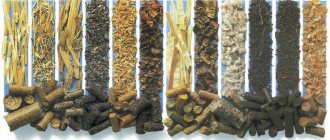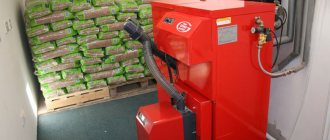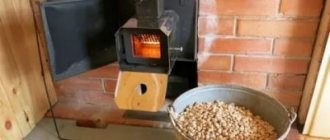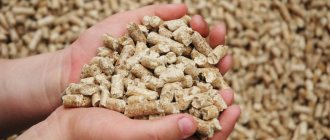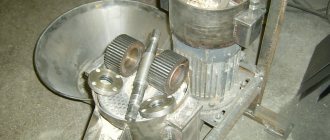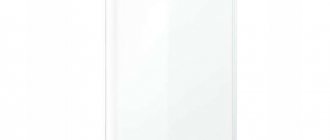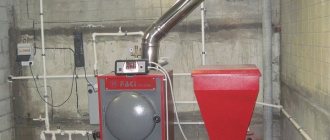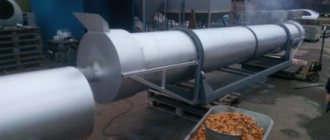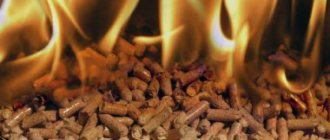December 31, 2021
Pellets are small-sized (diameter 4–8 mm, length 0.5 to 7 cm) cylindrical wood pellets, manufactured using special equipment and intended mainly for heating. In Western European countries, pellets have long been successfully used for heating cottages and country residences. In our country, this product became popular not so long ago. One of the main advantages is the environmental friendliness of the raw materials. An important advantage and ability to use pellets in automated systems: loose granules are poured into a special tank and fed into the boiler in an automated way, without any human participation in this process. This is a significant advantage over other types of solid fuel: chopped wood, coal, briquettes, which regularly need to be added manually to the stove to maintain the combustion process. Fuel pellets retain heat well, which means that your house or apartment will always be warm and comfortable.
Fuel pellets
A low degree of humidity contributes to the rapid combustion of raw materials, high efficiency and heat transfer, and the high bulk density of pellets simplifies transportation and storage, and increases the operating time of the boiler on one load.
Pellet consumption
When designing a heating system in a private home, the issue of choosing a power source is acute. Of course, the gas boiler remains the easiest to maintain and the most economical in our country. But such systems are not safe. In addition, if you live in a remote, ungasified region, and the main gas pipeline runs very far from home, there is no way to extend it, there are not many options left:
- electrical appliances (warm floors, electric boilers, infrared heaters, etc.);
- solar collectors;
- solid fuel.
The use of electrical appliances is irrational in terms of heating costs. Not everything is clear with solar collectors either. What remains is solid fuel: coal, firewood, briquettes, pellets.
Solid fuel
Which of these fuels should you prefer? And there is no clear answer here. If we talk about ease of use, then the best choice is pellets, which allow you to automate the heating process. But this also leads to a minus: you need to purchase a pellet boiler (which is not cheap). It has a hopper for filling pellets: from the hopper, using an auger, pellets are fed into the firebox.
Fuel boiler
Both pellets and briquettes have minimal humidity, which makes them 1.5–2 times more economical than conventional firewood. Pellets have almost the same consumption as coal. But at the same time, pellets for the boiler (white, premium grade) have low ash content.
Construction of pellet boilers
Pellets are solid fuel that is produced from wood waste, peat and agricultural waste. In fact, these are pressed pellets of small diameter, up to 5 cm in length. The main advantage of pellets over other types of solid fuel is their low ash content; therefore, the need to remove soot arises less often than when using firewood
If the impact on the environment is important to the home owner, then pellets cause minimal harm to the environment. Operating principles of a pellet boiler - pellets are loaded into a hopper, then they are fed into the firebox, where they burn, releasing heat
The most important thing is that all processes are controlled automatically. Those. if you need to quickly warm up the house before guests arrive, a pellet boiler will burn fuel at maximum speed, feeding pellets into the firebox using an auger. As soon as the required temperature is reached, the equipment will switch to temperature maintenance mode, reducing the fuel supply rate.
Burners in pellet boilers are divided into two types - retort and flare. A retort burner is a bowl with slots into which pellets fall and ignite under the influence of hot air. In torch-type burners, pellets are fed to a platform where hot air creates a torch directed horizontally. There are no clear advantages for any type of burner, so when choosing specific equipment it is not a decisive factor.
Flare-type burners are used in the Metal-Fach Smart BIO line. Smart BIO is the company’s own development; the burner is made in the form of a trench. Designed for burning pellets and grain. The design of the firebox allows the use of coal and firewood.
Most pellet boilers are equipped with an automatic ignition system. The absence of such a function means that the process must be started manually each time, which significantly reduces ease of use. If there is automatic ignition, the boiler can start heating the house on its own using a timer, sensor or command from a mobile phone.
The Metal-Fach SEG BIO model allows you to light a fire from anywhere on the planet by simply sending the appropriate command from your phone or via the Internet. In emergency cases, wood or coal can be used as fuel, but pellets are preferable.
Metal-Fach SD DUO BIO is designed for minimal environmental impact - it is designed for the use of pellets. It can also work on eco-seed coal, wheat grains, and grape seeds. The equipment is automated - there is automatic feeding, automatic ignition, and can be controlled from a cell phone and via the Internet. In addition, boilers of the SD DUO series have a water-filled grate, which increases heat removal. It is worth noting that SD DUO boilers are the flagship in the line of boilers of the Polish company Metal-Fach.
How many pellets are needed for the heating season?
Pellet consumption
To calculate fuel consumption for the heating season, you need to know:
- boiler power (Pk);
- duration of the heating season (D).
Consumption = (Rk × D × 24 hours × 30 days × 0.7) / 3.5 kW/h.
The coefficient of 0.7 is included in the formula for a more accurate calculation, since the boiler will not operate at full capacity all the time. 3.5 kW/h – calorific value of 1 kg of pellets.
Let's consider an example calculation for a private house with an area of 200 m2, for heating which requires a 20 kW boiler, and the duration of the heating season is 6 months. Substituting these data into the formula above, we get:
Consumption = (20 × 6 × 24 × 30) / 3.5 = 17280 kg. It turns out that to provide heating for a house of 200 m2 for the winter, 17 tons of pellets will be required. At the time of writing (December 2021), one ton of pellets costs an average of 8.5 thousand rubles. This means that to purchase pellets for the entire heating season you will need 144,500 rubles. Draw your own conclusions. Is it worth purchasing this product or using a cheaper one - RUF briquettes.
What are pellets made of?
To produce pellets, they take waste that is supplied by wood production: dust, chips, sawdust, trimmings - any raw material containing lignin is suitable. In Russia, coniferous wood is most often used, although deciduous wood is significantly superior in quality. The use of needles is explained simply:
- for processing hardwood you need other, more complex and expensive equipment;
- Birch does not press very well.
But if you are lucky enough to find birch pellets on the market, it is better to prefer them. They release slightly more heat during combustion. In addition, when burning, birch fuel pellets do not form (unlike coniferous species) resins, which subsequently settle in the chimney pipe.
Pellet manufacturing technology
The production of pellets consists of pressing waste that has been previously dried to a certain moisture content and crushed to a given fraction under a pressure of about 300 atmospheres. At the same time, the use of glue and other additives is prohibited (sometimes unscrupulous businessmen add sand and other non-combustible impurities to them to increase the weight of the granules, and synthetic polymers to ensure adhesive properties).
Main stages of pellet production:
- Grinding. The raw material enters the crusher and is crushed to a given fraction;
- Drying. The resulting raw material is dried to the moisture percentage specified by the technology (about 10% plus or minus 2%);
- Pressing. The dried raw material enters a press granulator, in which it is pressed into granules of a given length and diameter. As a result of compression, friction, and adiabatic processes, the temperature can reach 100°C Celsius, as a result, thermal energy is generated that softens lignin and the particles stick together into granules. This process is called pelletization;
- Cooling. To ensure the strength of the fuel granules, the pellets are cooled after pressing;
- Packing and sending to the consumer.
In some cases, water treatment and additional grinding are performed before pressing; everything directly depends on the type and quality of the raw materials from which the granules are made. Pressing is carried out in molds, ring-type dies using rotary rollers (rollers), which press the raw material into cone-shaped dies located on the matrix. On the other hand, the resulting granules are cut with special knives. After cooling, the pellets are sieved and small particles are sent for recycling. Closed cycle technology is virtually waste-free; only non-combustible impurities are removed. In order to make one ton of pellets, three to five cubes of wood waste are needed. The raw material is compacted approximately three times. To prepare one ton of pellets you need from 30.00 to 50.00 kW per hour.
Main types and features
All pellets existing on the market can be divided into 3 types:
- Industrial.
- Agropellets.
- White.
The use of industrial pellets in a home boiler can lead to its failure. These granules are dark in color. Their ash content is higher than 0.7 due to the fact that, along with sawdust and dust, the composition contains impurities of tree bark. But some boilers can work with such fuel. Considering that the price of the pellets in question is almost half as much, this is a significant saving.
Industrial pellets
Agropellets are made from agricultural waste: straw, jute husks. The heat transfer of agricultural pellets is lower, but they are much cheaper. The ash content of such pellets is environmentally friendly and can serve as a good fertilizer for the soil. But the formation of large amounts of ash, again, can become a problem for many domestic boilers. The use of agro-pellets means that boilers will have to be cleaned regularly, so they are more suitable for boiler rooms.
Agropellets
And finally, white pellets. This is a premium look. They exude a fragrant woody smell. The ash content of white granules is only 0.5%. By loading such raw materials into the boiler, you can forget about the need to clean the boiler for a long time.
White pellets
Fuel pellets for the boiler - heating using pellets. Types, varieties, pellet production
Pellets or granules are a modern, environmentally friendly and renewable fuel intended for use in heating cottages, private houses, as well as industrial buildings using special fireplaces and boilers.
Fuel pellets (granules) for heating
Pellets are made from wood processing waste, agricultural products and waste from other sectors of the national economy by pressing into small cylindrical granules (pellet diameter - 6...10 mm, length - 50 mm), photo 1.
Photo 1. Pellets
Pellet boilers are characterized by ease of installation, automation of adjustment and control of the heating process.
Pellet boilers are divided into two types:
- with a remote burner (for industrial enterprises);
- with an integrated burner (for private homes, cottages).
Pellets are widely used in Western Europe and North America. In some European countries, heating of private houses using pellets reaches 50%. In 2008, Europe produced the largest number of pellets:
- in Sweden - more than 1.7 million tons;
- in Germany – 900 thousand tons;
- in Austria – 800 thousand tons.
The global consumption of pellets is approximately 22.5 million tons. (2013), and in Europe 2/3 of heated areas are heated with pellets.
What types of pellets are there?
Pellets or granules come in the following types, photo 2:
- woody (the most common);
- coal;
- peat;
- from vegetation (for example, from buckwheat husks, sunflowers);
- straw pellets;
- from corn waste;
- from chicken manure;
- from solid household waste.
Photo 2. Types of pellets made from: a) birch sawdust; b) buckwheat husk; c) rapeseed stalks; d) rye (straw); e) rice husk; f) sunflower seed husks; g) peat; h) barley (straw); i) pine sawdust
The most effective and high-quality are wood pellets, which are suitable for household solid fuel boilers running on this fuel. Pine pellets have proven themselves especially well, as they are practical to use: they have high strength and do not crumble into powder during transportation and overload.
For domestic boilers it is not recommended to use:
- pellets from other raw materials (except wood);
- pellets, in the production of which chemical adhesives were used (there is a high probability of releasing toxic gases during combustion).
- pellets of low quality, with an admixture of soil and sand particles, which leads to the deposition of slag on the elements and walls of the boiler combustion chamber.
The above pellets lead to a decrease in efficiency and a reduction in the service life and durability of the boiler.
What types of fuel pellets are there?
The following types of pellets are produced:
- the highest grade “premium” , they are also called “white”. The cost is high compared to other varieties due to higher quality raw materials. Color white, beige, light brown. The raw materials for such pellets are sawdust of oak , beech and other hardwoods;
- industrial (industrial). They have dark colors due to the addition of tree bark to the composition. The calorific value is high, but the ash content is higher - 0.7% or more. The cost of such pellets is lower than premium pellets;
- agropellets “standard” (a type of industrial pellets). Made from sunflower and buckwheat husks. Pellets are dark in color, have a high ash content - 3% or more, low calorific value - 15 MJ/kg, table. 1. The cost of agropellets is the lowest. Agropellets are intended for thermal stations and industrial boilers.
Comparative characteristics of buckwheat and wood pellets
Table 1
| Type of fuel | Heat of combustion, kcal/kg | Price, $ |
| Buckwheat husk pellets | 4300 | 115 $/t |
| Wood pellets | 4500…5000 | 150…180 $/t |
Important! When choosing pellets for heating a private home, you should pay attention to the following points and indicators:
- You should require a certificate of pellet quality (composition), compliance with current standards. It is desirable that the pellets meet European standards such as EnPlus, DinPlus;
- calorific value (not less than 4200 kcal/kg);
- ash content (no more than 0.5...1%);
- humidity (no more than 8...14%).
The boiler efficiency depends on the calorific value, ash content and humidity. You can also visually determine the quality of the pellets. High-quality pellets have a smooth, shiny surface without visible longitudinal cracks, should be durable and not break easily under your hands. The color can vary: from light beige to brown. Color does not affect the quality of the pellets.
Advantages of using pellets for space heating
- High efficiency of pellet boilers.
- High calorific value. For example, 2 tons of wood pellets, when burned, release an equivalent amount of heat equal to the combustion of 1000 liters of diesel fuel, 3.2 tons of firewood, 1370 liters of fuel oil and 957 m3 of natural gas. From the table 2 and table. 3 shows that pellets emit more heat during combustion than sawdust or wood chips.
Comparative characteristics of different types of fuel
table 2
| Type of fuel | Heat of combustion MJ/kg | % sulfur | % ash | Carbon dioxide kg/GJ |
| Coal | 15…25 | 1…3 | 10…35 | 60 |
| Diesel fuel | 42,5 | 0,2 | 1 | 78 |
| Fuel oil | 42 | 1,2 | 1,5 | 78 |
| Wood chips | 10 | 0 | 2 | 0 |
| Wood pellets | 17,5 | 0,1 | 1 | 0 |
| Peat pellets | 10 | 0 | 20 | 70 |
| Straw pellets | 14,5 | 0,2 | 4 | 0 |
| Natural gas | 35…38 MJ/m3 | 0 | 0 | 57 |
Note: “0” means that when burning fuel, the amount of CO2 is equal to or less than the amount of CO2 during the decomposition of this fuel.
Calorific value of pellets and other fuels
Table 3
| Type of fuel | Thermal capacity, kcal/kg |
| Pellets | 4500 |
| Firewood | 2500 |
| Charcoal | 7500 |
| Coal | 7400 |
| Fuel oil | 9800 |
| Diesel fuel | 10200 |
| Natural gas | 8300 |
- Simple storage conditions for pellets.
- Low amount of ash formation. The boiler is cleaned from ash 1…2 times a week. The amount of ash from the combustion of pellets is 10...20 times less than in the case of using firewood.
- The combustion efficiency of pellets reaches 99.3%.
- Automatic combustion temperature adjustment.
- Automatic loading of fuel into the combustion chamber, photo 3.
Photo 3. Automatic loading of fuel into the combustion chamber
- High resistance to spontaneous combustion.
- Eco-friendly fuel. No chemical binder is used in the production of granules. Granules are obtained due to compressive force. The adhesive is lignin, which is released when compressed. When burned, wood pellets have 10...50 times lower carbon dioxide emissions and 15...20 times lower ash formation than when burning coal.
- Do not rot, do not swell (peat, coal pellets).
- Relatively low price compared to natural gas and other fuels. The wholesale cost of 1 ton of pellets is $110...130.
- High bulk density, which allows large quantities to be transported in one truck.
- High durability of boilers operating on pellets (more than 20 years).
Disadvantages of using pellets
- To burn pellets, you need a special boiler or you need to convert a solid fuel boiler.
- When purchasing fuel pellets in small quantities, their price will be quite high.
Pellet production technology
- Coarse crushing . Raw materials (sawdust, wood chips, bark) are crushed and ground into sawdust and flour using special crushers and mills.
- Drying the crushed material to a moisture content of 8...10% in drum or belt dryers, photo 4.
Photo 4. Drying crushed material in dryers
- Additional grinding of raw materials in hammer mills to particle sizes of 4...6 mm.
- Compression (pressing) under pressure on a granulator press at a temperature of 110...120°C, photo 5. The granulator press comes with a flat or cylindrical matrix, roller or screw type, photo 6. The productivity of a mini granulator press can reach 200...250 kg /hour.
- Cooling of pellets (as needed).
- Packing pellets into bags, photo 7.
It is calculated that to produce 1 ton of pellets, 2.5 m3 of wood waste is needed, and according to other sources, 5...6 m3 are needed. Household pellets are produced in bags of 15...30 kg or industrial pellets of 300...1000 kg.
Examples of lines for the production of wood pellets are shown in photo 8. The cost of a small line based on OGM-1.5 is about $55,000. The cost of industrial lines is much higher and depends on productivity:
- 100…700 kg/h – about $132,000;
- 2000 kg/h – about $196,000.
The production of peat pellets consists of the following stages:
- preliminary light grinding;
- peat drying;
- pressing;
- packaging.
Photo 5. Pressing pellets
Photo 6. Types of presses for making granulators
Photo 7. Packaging of pellets
Photo 8. Main components of granulation and pellet production lines
Different countries have their own quality standards for pellets. In the CIS countries, there are still no government regulations for the use and production of pellets.
Here are some standards in different countries:
- USA – Standard Regulations & Standards for Pellets in the US, 2 grades of pellets are produced: “Premium” and “Standard”;
- Germany – DIN 51731;
- Austria – ONORM M-7135;
- UK – The British BioGen Code of Practice for biofuel (pellets);
- Switzerland – SN 166000;
- Sweden - SS 187120.
In table 4 shows the main European pellet quality standards.
Basic European pellet quality standards
Table 4
| Characteristic | DIN 51 731 | Onorm M-7135 | DINplus | SS 187120 |
| Germany | Austria | Germany | Sweden | |
| Diameter (mm) | 4-10 | 4-10 | ||
| Length (mm) | < 50 | < 5*d | < 5*d | < 5*d |
| Density (kg/dm3) | > 1,0…1,4 | > 1,12 | > 1,12 | — |
| Humidity (%) | < 12 | < 10 | < 10 | < 10 |
| Bulk mass (kg/m3) | 650 | 650 | 650 | 650 |
| Briquette dust (%) | — | < 2,3 | < 2,3 | — |
| Ash content (%) | < 1,5 | < 0,5 | < 0,5 | < 1,5 |
| Heat of combustion (MJ/kg) | 17,5…19,5 | > 18 | > 18 | > 18 |
| Sulfur content (%) | < 0,08 | < 0,04 | < 0,04 | < 0,08 |
| Nitrogen content (%) | < 0,3 | < 0,3 | < 0,3 | No |
| Chlorine content (%) | < 0,03 | < 0,02 | < 0,02 | < 0,03 |
| Arsenic (mg/kg) | < 0,8 | — | < 0,8 | — |
| Lead (mg/kg) | < 10 | — | < 10 | — |
| Cadmium (mg/kg) | < 0,5 | — | < 0,5 | — |
| Chromium (mg/kg) | < 8 | — | < 8 | — |
| Copper(mg/kg) | < 5 | — | < 5 | — |
| Mercury(mg/kg) | < 1,5 | — | < 1,5 | — |
| Zinc(mg/kg) | < 100 | — | < 100 | — |
| Fixer, binding materials (%) | — | < 2 | < 2 | — |
Publication prepared by GIDproekt expert
Konev Alexander Anatolievich
Application areas of fuel pellets
As has been noted more than once above, the main area of application for pellets is heating boilers. But it doesn't end there. In addition to boilers, there are grill stoves with automatic pellet feeding. You can cook delicious shish kebab, barbecue and other dishes in them.
Pellet grill stove
Wood pellets are actively used by farmers as bedding for goats, horses, cows and other animals. Pellets absorb liquid and unpleasant odors well in paddocks and stables. They are an excellent alternative to straw, which has been used for centuries for bedding in barns and stables. But fungi and other pathogenic microorganisms quickly grow in straw, which lead to the development of allergic diseases in animals. It is impractical and takes up a lot of space during storage and transportation. Therefore, using pellets is the best option: they are easier to transport and store, they are not eaten by animals, they are warm, soft and comfortable for livestock. However, not only farmers noted such advantages in pellets as the ability to absorb a lot of moisture and neutralize odors: wood pellets are often used by manufacturers offering cat litter. Soft pellets that do not stick to cat paws are very popular with pets.
Pellets for animals
Calculation of pellet consumption initial data
For calculations performed to determine the theoretical fuel consumption for heating a country house, it is necessary to collect the following initial data:
- the amount of heat load on the heating system of a cottage or country house, expressed in kW;
- Efficiency of the pellet boiler model that you plan to install in your furnace room;
- calculated heat of combustion of fuel pellets;
- To get the result in monetary terms, it is advisable to find out the price per ton of pellets in your region of residence.
The most difficult thing is to obtain a figure for the actual heat load, which consists of heat losses through external walls, roofing, glazing and floors, plus the cost of thermal energy to warm up the ventilation air.
The ideal option is to contact a qualified heating engineer for such a calculation, then you will find out the exact figure. Otherwise, you will have to calculate the thermal load and fuel consumption in aggregated ways:
- Based on specific heat consumption per square meter of area. For dwellings in central Russia, it is assumed that in a room with 1 window and one external wall, 100 W of heat per 1 m² will be consumed, with two external walls - 110 W/m², with 2 walls and two windows - 120 W/m².
- The same applies to the volume of the building. The method is used when the ceilings in the rooms are higher than 2.8 m. The total volume of heated rooms is calculated and multiplied by 40 W.
In the calculation example discussed below, the heat load for a private house of 100 m² is conventionally assumed to be 10 kW, since pellet consumption is determined in an abstract building with a pellet boiler from an unknown manufacturer.
The efficiency of a heat generator that burns wood pellets is indicated in its technical data sheet. If the model and manufacturer have not yet been selected, then for calculations you can take the figure of 80%. Manufacturers leading the rating of heating equipment (for example, Viessmann or Buderus) declare the efficiency of their pellet boilers to be 85%. But these are high-quality and reliable products whose cost cannot be called low. For equipment with a more affordable price, the performance is not so high.
The theoretical calorific value of pellets is a known value; it lies in the range of 4.9–5.2 kW/kg, depending on the quality of the fuel and the raw materials from which they are made
If you do not take into account peat granules with high ash content and low heat transfer, then for calculations it is worth taking the average figure - 5 kW / kg
Features of pellet heating systems
In order to evaluate the effectiveness of pellet heating, you need to know about the difference that exists between ordinary firewood and pellets. During the production of pellets, wood processing waste is used. The raw materials for the production of pellets or ordinary sawdust are first thoroughly dried, then treated with steam, resulting in the formation of a viscous mass, from which cylindrical granules with a length of about 70 mm and a diameter of 6 to 8 mm are formed under pressure of 300 atmospheres. Boilers supplied to the market by pellet manufacturers equipment, differ from their analogues that use ordinary firewood as fuel by a higher degree of heat transfer. Quantitative indicators of the calorific value of various types of solid fuel are indicated in the table.
| Type of fuel | Heat of combustion (kW/kg) |
| Firewood | 2,84 |
| Fuel briquettes | 4,7 |
| Pellets | 4,99 |
In addition to high heat transfer, pellet boilers have another advantage - their combustion chamber is loaded automatically. Automatic fuel supply is implemented as follows:
- A certain supply of pellets is stored in a special hopper made of stainless steel. The presence of a large-volume bunker allows you to refuel it once every few days.
- The fuel enters the boiler through a flexible cable and an auger located inside it. The granules' own weight causes the auger to rotate, which ensures their supply to the distribution chamber of the boiler in the required quantity.
- Next, from the distribution chamber, the pellets enter the air burner zone, where they are incompletely burned, accompanied by the release of wood gas.
- The main source of high heat transfer is wood gas, which burns completely in the afterburner.
This design of the boiler allows its owner, during continuous operation of the equipment, to fill the bunker with fuel only once every 3-4 days and remove solid combustion products, i.e. ash.
